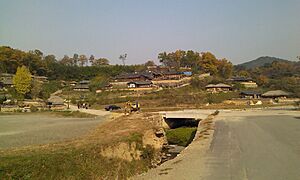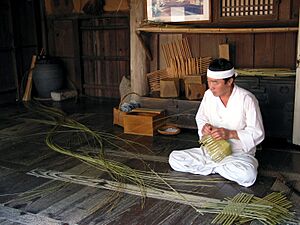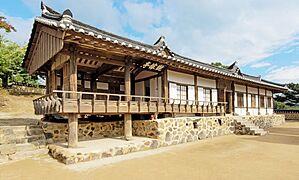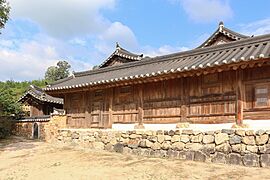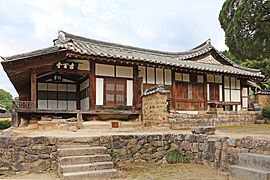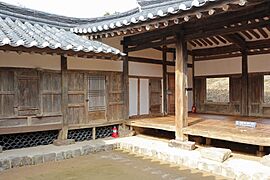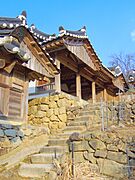Yangdong Folk Village facts for kids
| UNESCO World Heritage Site | |
|---|---|
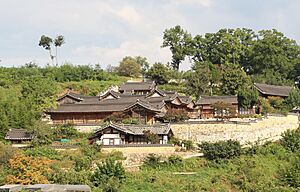
Yangdong Village
|
|
| Location | Gangdong-myeon, North Gyeongsang Province, South Korea |
| Part of | Historic Villages of Korea: Hahoe and Yangdong |
| Inscription | 2010 (34th Session) |
| Area | 91.6 ha (226 acres) |
| Buffer zone | 237.4 ha (587 acres) |
| Korean name | |
| Hangul |
경주양동민속마을
|
| Hanja | |
| Revised Romanization | Gyeongju Yangdong Minsok Maeul |
| McCune–Reischauer | Kyŏngju Yangdong Minsok Maŭl |
Yangdong Folk Village (Korean: 경주양동민속마을), also known as Yangdong Village of Gyeongju, is a very old and special village in South Korea. It was home to the yangban, who were the upper-class people during the Joseon dynasty. The village is located in Gangdong-myeon, about sixteen kilometers northeast of Gyeongju. It sits along the Hyeongsan River, with Mt. Seolchang to its north.
Yangdong Village is super important because it is very well-preserved. It has many cultural treasures and keeps old traditions alive. The village also shows how the yangban lived and followed Neo-Confucianism. In 2010, the South Korean government and UNESCO listed Yangdong Village as a World Heritage Site, along with Hahoe Folk Village.
Contents
Exploring Yangdong Village's History
Yangdong Village was started by a person named Son So (1433–1484). His family, the Wolseong Son clan, chose a lucky spot for their home. This was based on Korean pungsu (which is like geomancy, a way of finding good places). Son So's daughter married Yi Beon from the Yeogang Yi family. Their son, Yi Unjeok, became one of Korea's eighteen wise people. Yangdong Village has been a living village since the 1400s!
Homes and Buildings in Yangdong
Even though some parts of the village are not lived in today, it still has over 160 homes. These homes have either tile roofs or thatched roofs and are built among thick forests. More than fifty historic homes, which are over 200 years old, are still standing. The village keeps old customs and traditional buildings from the Joseon dynasty.
Some important homes and buildings include:
- Seobaekodang: This was the main house for the Wolseong Son Family.
- Mucheomdang: This was the main house for the Yeogang Yi family.
- Hyangdan: This building is so important it's called National Treasure No. 412.
- Other notable places are Ihayangjeon and Simsujeong pavilions, and the Ganghakdang village school. Gwangajeong and Sonsoyeongjeong are also special.
- A very old book, Tonggamsokpyeon, printed with movable metal type, is also in the village. It is National Treasure No. 283.
Important Cultural Items
Yangdong Village is home to many important cultural items. These include old houses and other historical objects. They help us understand life in the past.
Some of these special items are:
- Seobaekdang (Important Folk Material No. 23)
- Nakseondang
- Sahodang
- Sangchunheon
- Geunam Manor
- Dugok Manor
- Sujoldang
- Ihyangjeong
- Suunjeong
- Simsujeong
- Allakjeong
- Ganghakdang
Other cultural treasures include:
- Jeokgae Gongsin Nonsang Rokgwan (Tangible Cultural Property No. 13)
- Sonso's Will (Tangible Cultural Property No. 14)
- A special Pine Tree in Yangdong
- Daeseongheon
- Son Jong-ro Jeongchungbigak (Cultural Asset Material No. 261)
- Gyeongsan Seodang (Folk Cultural Asset Material)
- Dugok Yeongdang (Folk Cultural Asset Material)
Village Layout and Social Life
The village is built to follow the shape of the mountains and valleys. It looks like a lucky Hanja character. This special arrangement has been kept safe for hundreds of years. The homes of the Wolseong Son and Yeogang Yi families, and their relatives, are on the higher parts of the mountains and valleys. The homes of the lower-class people, which had thatched roofs, were built on lower ground. This shows how society was very structured during the Joseon dynasty.
Did you know that Prince Charles visited Yangdong Village in 1993?
Gallery
See also
 In Spanish: Yangdong para niños
In Spanish: Yangdong para niños


